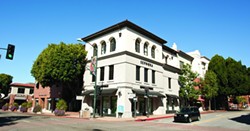On April 2, an East Coast real estate investment firm bought $100.5 million worth of ownership interests in downtown San Luis Obispo from Copeland Properties. The deal matches Jamestown Funds—a national investor with a reputation for ambitious redevelopment projects—with one of the more protectionist and slow-growth cities on the California coast. To make matters more curious, the properties in question present little opportunity for transformation.

- PHOTO BY STEVE E. MILLER
- SOLD : Court Street and the Downtown Centre comprise the bulk of the $100.5 million in property interests purchased from Copeland Properties April 2 by Jamestown Funds.
The deal finalized on April 2 places a still-undisclosed percentage of the Downtown Centre and Court Street shopping centers into a Jamestown mutual fund. Copeland developed Downtown Centre and Court Street between 1995 and 2005. The latter underwent a seismic retrofit in 2007 that triggered a wave of gentrification in its tenant businesses.
Both Copeland and Jamestown declined to answer questions on the underlying financial reasons for the transaction or the long-term plans for the two downtown properties. However, Tom Copeland said in a written statement that management power would remain in local control.
“Copeland Properties will continue to manage the portfolio,” he wrote, adding, “The Chinatown development and other properties owned by us in San Luis Obispo are not part of this partnership transaction.”
Assistant City Manager Michael Codron confirmed that neither Copeland nor Jamestown has approached the city regarding plans to develop any of the downtown properties included in the deal.
Jamestown manages a handful of large real estate mutual funds with shares trading on the public markets. Since founders launched the Atlanta-based firm in 1983, Jamestown has amassed more than $8 billion in real estate holdings under these various funds, most of it on the eastern seaboard.
The portfolio involved in the transaction consists of 195,000 square feet of retail and 28,000 square feet of office space. In exchange, Copeland stands to receive a $50.5 million equity investment in one of the firm’s larger mutual funds and Jamestown will assume $50 million in Copeland debt.
The two properties contain relatively few local tenants, but those contacted by New Times said they didn’t mind an East Coast owner as long as management remains local.
“As a business owner, I realize the limitations of being able to finance locally,” Powell’s Sweet Shoppe owner Miranda Battenburg said.
Under the terms of the deal, the San Luis Obispo properties will become part of Jamestown’s Premier Property fund along with a 430,000-square-foot mixed-use property the firm recently purchased on Market Street in San Francisco. The fund is open-ended, meaning Jamestown can freely issue or redeem shares in response to market demand.
Redevelopment specialist
The model of the open-ended mutual fund is consistent with Jamestown’s specialty: large-scale redevelopment projects in the urban core of major metropolitan areas. Jamestown earned fame for turning an abandoned biscuit factory in midtown Manhattan into Chelsea Market, an indoor shopping, office, and creative production complex that now rents for $70 a square foot. More recently, it converted a 2 million-square-foot Sears distribution center into a mixed-use commercial leviathan near downtown Atlanta.
Given Jamestown’s track record, the SLO deal seems a departure from the firm’s redevelopment-centered modus operandi. Both the Downtown Centre and Court Street are already developed to the extent permitted by San Luis Obispo’s build-out restrictions. None of the properties in the portfolio has any great historic value, nor do they have any special attributes, such as low-income housing stock or nearby transit lines, that would allow for Jamestown to take a tax write-off.
Jamestown Chief Operating Officer Michael Phillips stated in a press release that the firm decided to invest in San Luis Obispo because of the city’s demographic profile. Jamestown also recently bought a property in downtown Berkeley. Like SLO, Berkeley boasts of an educated and upwardly mobile population rooted in a town with established tourism appeal and a pedestrian-friendly downtown.
“The acquisition is part of Jamestown’s strategy to acquire street-level retail in vibrant markets with a strong sense of community,” Phillips said.
On the other side of the table, Copeland’s silence on the company’s motivation for entering the deal leaves the matter open to speculation. No news report yet published on the sale has provided a response from Copeland on what event or need prompted the company to sell off such a significant portion of its downtown assets. Despite the fact that Jim and Tom Copeland lost their sporting goods business to Chapter 11 bankruptcy in 2006, the brothers’ downtown portfolio has kept the family financially healthy.
Yet, the recession certainly impacted the demand for premier downtown retail space, and the Chinatown redevelopment project has been mired in cost-building delays. It’s possible that Copeland needed a cash infusion or debt relief to keep up with the city’s timetables for buying municipal property necessary to compete the project, but that’s just speculation.
To that end, Jamestown certainly had the cash on hand. According to the firm’s 2012 prospectus—a document regulated by the Securities Exchange Commission—Jamestown’s various publicly traded mutual funds have all posted growth since the investment crash of 2008.
Staff Writer Patrick M. Klemz can be reached at [email protected].
Comments